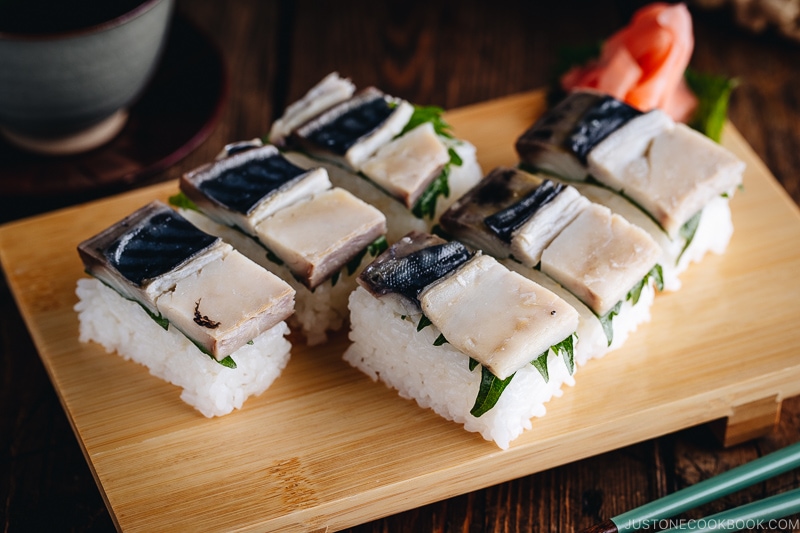
Impress your family and friends by learning how to make unique, delicious and beautiful Pressed Sushi (Oshizushi). This Mackerel Pressed Sushi is made of three layers: an aburi-style mackerel, shiso, and sushi rice.
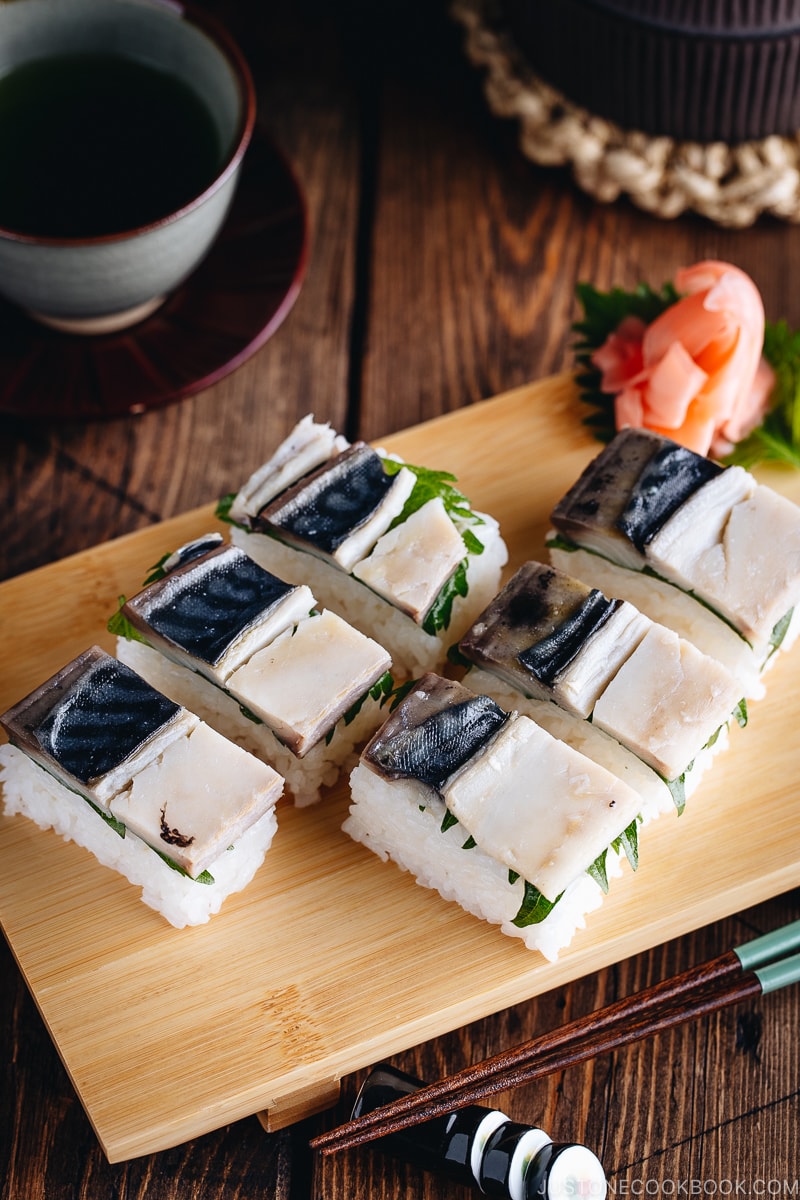
How many types of sushi do you know? The most common kinds of sushi in Japan include Nigiri Sushi, Maki Sushi, Temaki Sushi, Chirashi Sushi, Temari Sushi, and Inari Sushi. Have you tried them all already?
Today I’ll introduce another popular variety, Pressed Sushi or Oshizushi (押し寿司). Among this type of sushi, the most popular one is Mackerel Pressed Sushi or Saba Oshizushi (鯖の押し寿司), so let’s make it today!
What is Pressed Sushi (Oshizushi)?
Pressed Sushi or Oshizushi is made from layers of cured fish and sushi rice that are placed in a special box called Oshibako (押し箱), and then compressed together by weight, making them into a tightly pack sushi stack. Mackerel Pressed Sushi consists of vinegar cured mackerel, shiso leaves, and sushi rice.
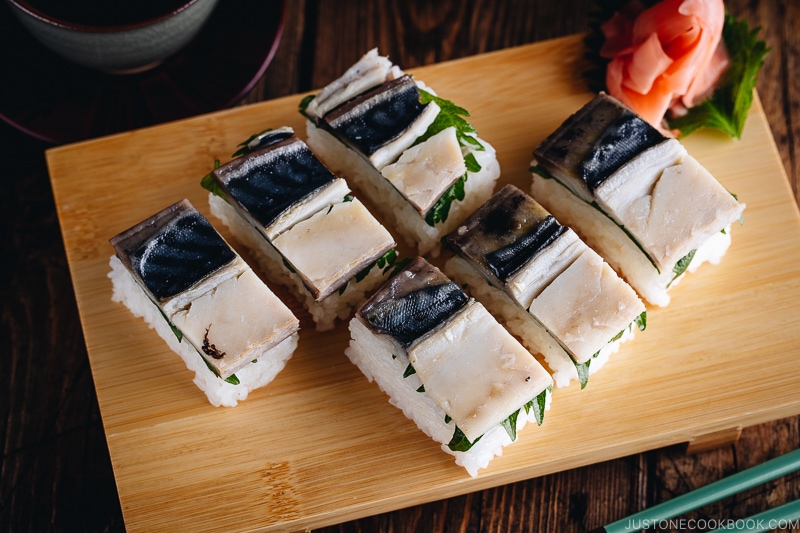
You may have seen fancier pressed sushi with multiple layers of sushi rice, seafood, and other ingredients. Oshibako creates a perfectly rectangular shape, and if you are ambitious, you can make eye-catching pressed sushi with a checkered pattern using colorful toppings (maybe someday for me!).
Is Battera same as Mackerel Pressed Sushi?
For those of you from Osaka or have traveled to Osaka, you may have heard of Battera (バッテラ) – a type of pressed sushi made with vinegar pickled mackerel. A fillet of mackerel is also placed inside the wooden box and filled with sushi rice. The difference is that after you remove the sushi out of the box, a super-thin, almost translucent sheet of kombu is placed on top of the mackerel before it’s cut and served. The addition of kombu is unique to the regional Osaka cuisine.
The name “Battera” doesn’t sound so Japanese, does it? That’s because the name derived from the Portuguese word bateria or “small boat” as the sushi made with the original method without the box looked very similar to a small ship from the side.
Watch How to Make Mackerel Pressed Sushi
Impress your family and friends by learning how to make unique, delicious and beautiful Pressed Sushi (Oshizushi).
What You Will Need:
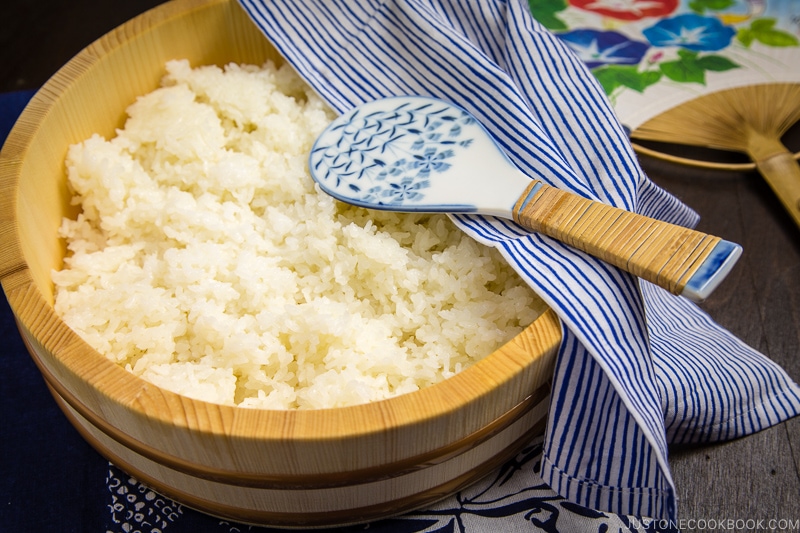
1. Sushi Rice
If you want to learn how to make sushi rice properly from scratch, this is the recipe with a video tutorial.
However, today I’ll show you something new. Did you know you can find two types of rice vinegar when you go to Japanese condiment isle? The first type is regular rice vinegar and the other one is “seasoned” rice vinegar. The one labeled as ‘Seasoned’ rice vinegar is basically sushi vinegar, specifically made to quickly prepare sushi rice!
When Japanese people talk about “Sushi Rice”, we’re referring to steamed rice seasoned with sushi vinegar called sushizu (すし酢).
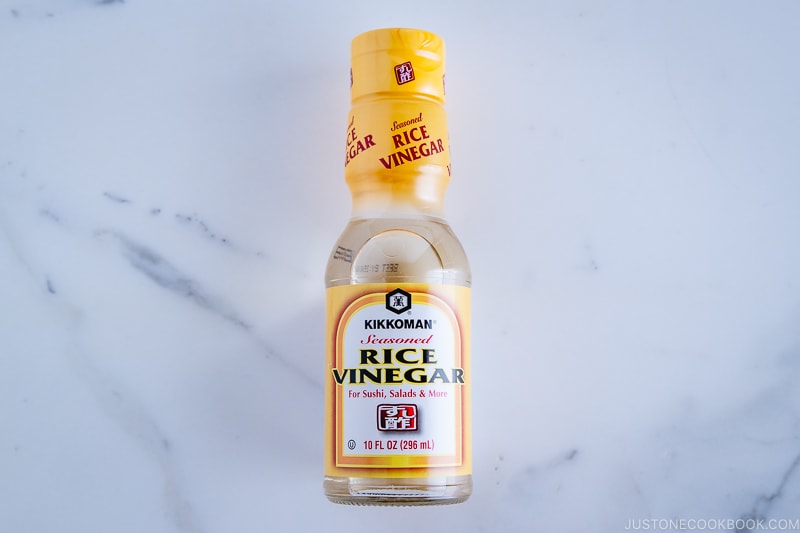
Sushizu or sushi vinegar is made of rice vinegar, sugar, and salt. It’s pretty simple, but when you’re in a hurry, it’s really convenient to just reach for the ready-for-use sushi vinegar instead of whisking your own.
Today I use Kikkoman Seasoned Rice Vinegar to make delicious sushi rice for this Mackerel Pressed Sushi recipe.
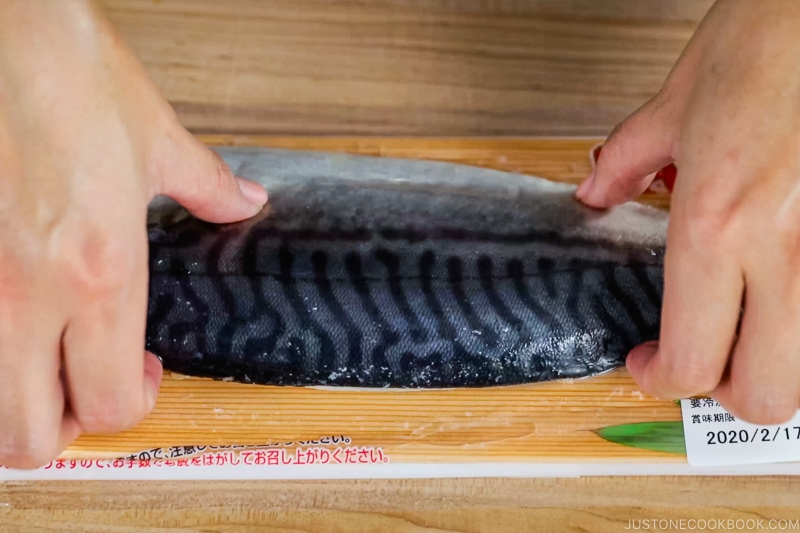
2. Vinegar Pickled Mackerel (Shime Saba)
For this recipe, you will need a special type of mackerel, not a fresh one. Mackerel is known to go spoiled easily, so the best way to preserve the fish is to cure them with vinegar. Cured and marinated mackerel is called Shime Saba (しめ鯖) in Japanese. You can easily find pre-marinated and packaged Shime Saba in the frozen section of Japanese or Asian grocery stores. The same brand Shime Saba I find is a bit cheaper in the Korean grocery store than the Japanese store in my area.
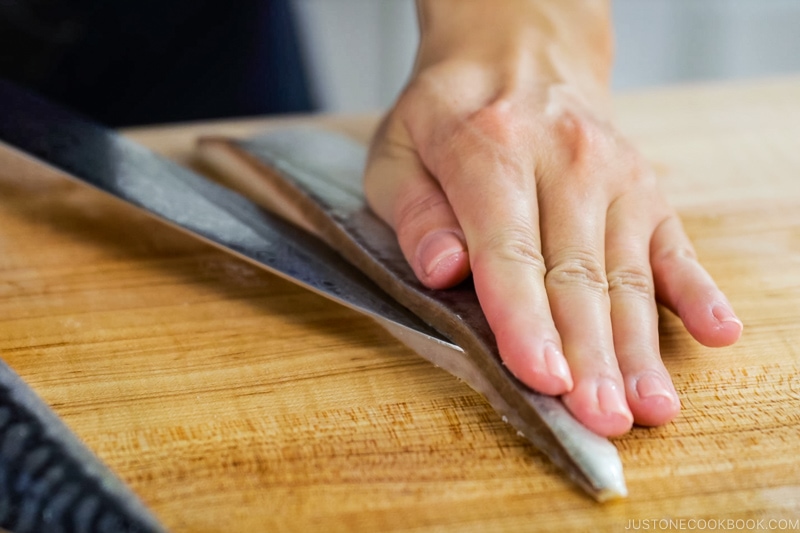
Since the mackerel fillet is uneven, being thicker in the middle and thinner toward the edge, I cut the fillet in half lengthwise and then butterfly each piece from the cut edge.
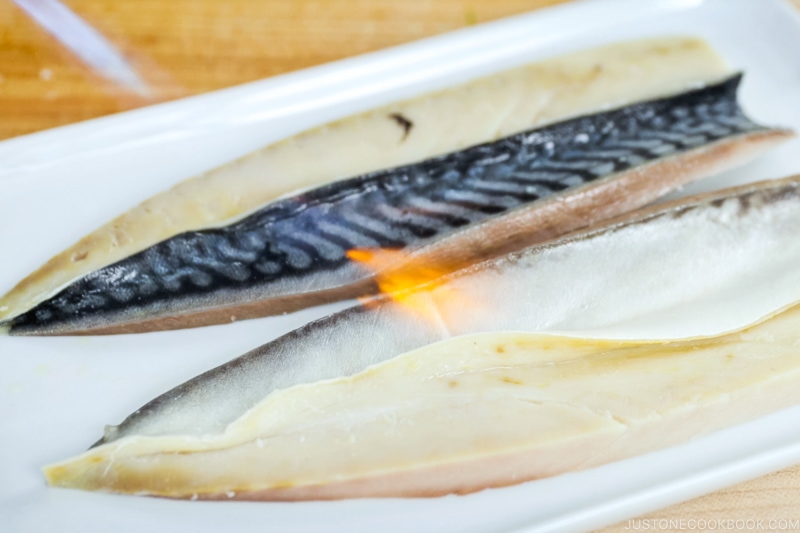
If you have a kitchen torch, I recommend searing the skin of the mackerel for an additional layer of flavors. When seared, we say Aburi Mackerel, Aburi Salmon, Aburi Toro, etc (Aburu 炙る is a verb; Aburi 炙り is a noun and adjective).
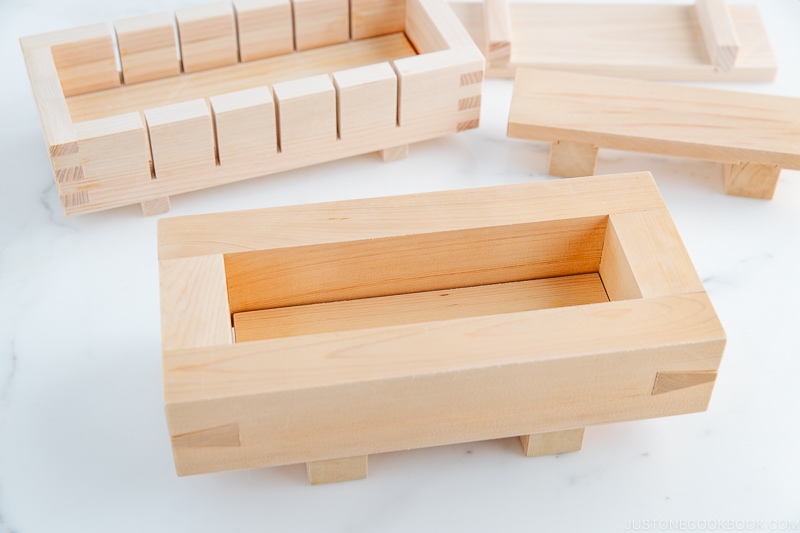
3. Oshibako (Sushi Press)
You will need an Oshibako (押し箱), or sometimes called Oshizushihako (押し寿司箱) or Hakozushigata (箱寿司型). It is a wooden box or mold, made of 3 parts: a bottom part, the rectangular walls, and a top part. The top and bottom parts resemble a traditional Japanese geta (wooden sandal).
Before you use the Oshibako, you will need to moisten the three parts so the rice will not stick to them. To assemble, you place the bottom part and then the rectangular wall part. After you place the ingredients inside, position the top part and put all your body weight down to compress the sushi. You can remove the box once you finished pressing. Wash the mold thoroughly and allow it to dry.
Do we need Oshibako to make pressed sushi?
For those of you who wish to try this recipe without using an Oshibako, you can get away with your own makeshift box. Use a rectangular/square container or bento box lined with plastic wrap so you can pull out the sushi later. You will also need something flat that fits inside the box to press down the sushi.
You can find a plastic oshibako online, but I like my oshibako made with Hinoki (Japanese cypress). It was my mom’s but I brought it back years ago. I love using traditional kitchen tools in my kitchen to keep the handicrafts alive and hopefully passing down the tradition to the next generation. You can find a similar Oshibako on Amazon.
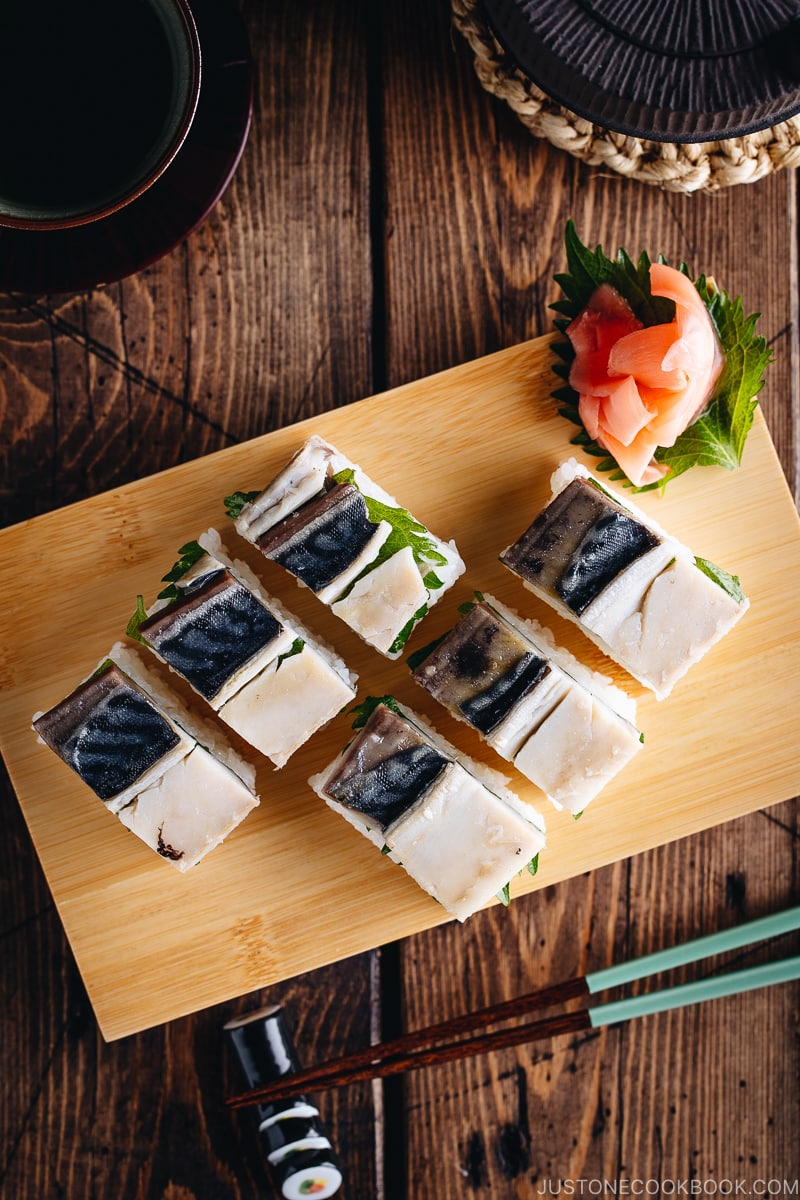
5 Tips to Make Perfect Pressed Sushi
I put together five tips that will be helpful when you make Oshizushi. Practice definitely helps, and as you make more Oshizushi, your sushi will be neater and prettier. I can definitely spend more time improving my Oshizushi skill.
- Moisten the Oshibako and hands with vinegar water (it’s called tezu).
- Add the fillings evenly, and don’t miss filling the four corners!
- Press using your body weight, not just the arms and hands.
- Use moistened cloth to wipe the knife every time you slice the sushi.
- When you cut the sushi, the knife motion should be “push forward and pull”.
Whether your pressed sushi turn out perfect or slightly off shape, I think they will still look impressive at the dinner table. There is just a touch of elegance to the presentation when sushi is shaped this way. I’d be so thrilled to see your creation, so please share your pictures with me!

Japanese Ingredient Substitution: If you want to look for substitutes for Japanese condiments and ingredients, click here.
Sign up for the free Just One Cookbook newsletter delivered to your inbox! And stay in touch with me on Facebook, Pinterest, YouTube, and Instagram for all the latest updates.
Mackerel Pressed Sushi (Saba Oshizushi)
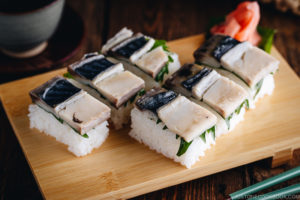
- 2 rice cooker cups uncooked Japanese short grain rice ((300 g or 360 ml))
- 1 frozen marinated mackerel fillet (shime saba) ((defrosted in the refrigerator overnight))
- 6 shsio leaves
- 4 Tbsp Kikkoman® Seasoned Rice Vinegar ((or homemade sushi vinegar; see below))
Homemade Sushi Vinegar Seasonings
- 4 Tbsp rice vinegar
- 2 Tbsp sugar
- 1 tsp salt (kosher or sea salt; use half if using table salt)
- Gather all the ingredients.
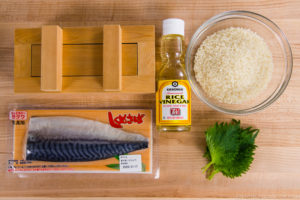
To Prepare Sushi Rice
- Measure the rice using a rice cooker cup and rinse under cold water by gently rubbing the rice with your fingertips in a circling motion. Submerge the rice in water and pour out the starchy water. Rinse and repeat until the water becomes clear.
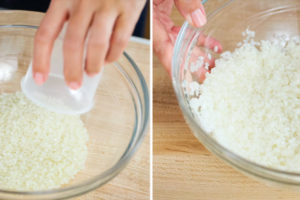
- Soak rice in water for 20-30 minutes.
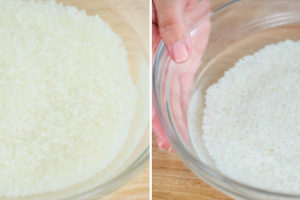
- Drain water completely and set aside for 10 minutes. If you don’t have time to wait, then shake off the excess water the best you can. Transfer the rice into the rice cooker.
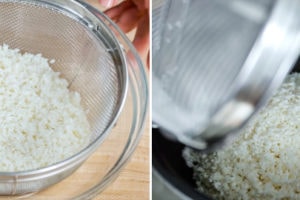
-
Pour water until “Sushi Rice” 2 cups (or a little bit less than regular 2 cups, if you don’t have “Sushi Rice” option) and start cooking. If you do not have a rice cooker, prepare 360 ml water (we use less water than regular rice as you will season the rice after the rice is cooked) and follow my recipe on how to cook rice in the Instant Pot or in the pot over the stove.
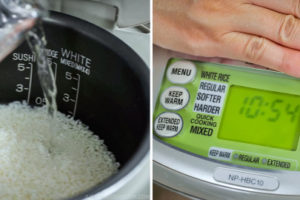
-
Once the rice is done cooking, fluff with a rice scooper/paddle. Moisten sushi oke/hangiri (a round, flat-bottom wooden tub) or a large bowl with water so the rice will not stick. Transfer the cooked rice into the sushi oke and spread out evenly so the rice will cool faster.
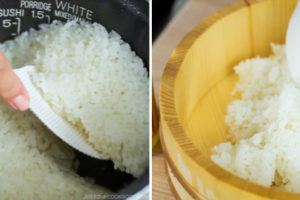
-
While it’s hot, mix 4 Tbsp Kikkoman® Seasoned Rice Vinegar (or homemade sushi vinegar into the rice. Add more or less to your liking. With a rice paddle, slice the rice at a 45 degree to separate the rice grains instead of mixing. Meantime, you need to use a fan to cool the rice so it will shine and doesn't get mushy.
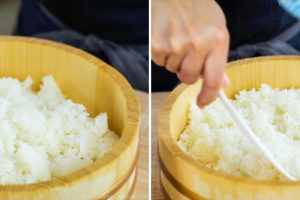
-
Then gently flip the rice in between slices. Repeat this process until the rice is cooled. Keep the rice covered with a damp towel (or paper towel until ready to use.
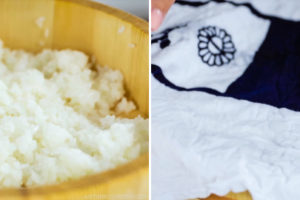
To Prepare Mackerel
-
Open the defrosted marinated mackerel fillet and cut the slab in half lengthwise.
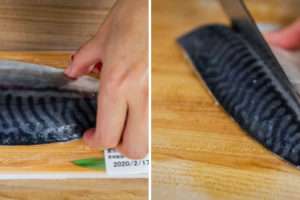
-
Butterfly the fillet from the long edge that you just cut. Please watch the video if you need more visual. Repeat the other half.
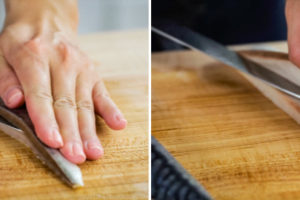
-
[Optional] Place the two pieces on a ceramic plate and use a kitchen torch to lightly sear the skin for nice char flavors.
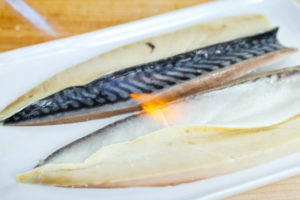
To Make Pressed Sushi
-
Prepare a small bowl with water and add 1 Tbsp Kikkoman® Seasoned Rice Vinegar (or rice vinegar). Moisten your hands so the rice won’t stick to them.
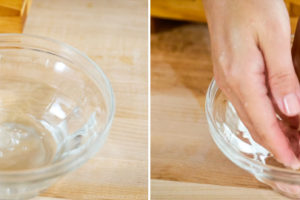
-
Assemble Oshibako mold with the bottom base and side so the top is open. Moisten it with the vinegar water so the rice won’t stick to it.
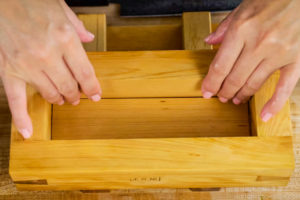
-
First, put the mackerel fillet at the bottom, skin side down. When the fillet is bigger than the box, cut off the excess and fill in all the voids if any.
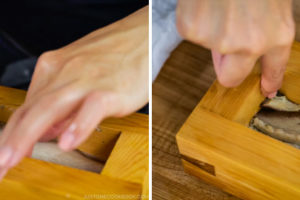
- Then add shiso leaves on top of the mackerel.
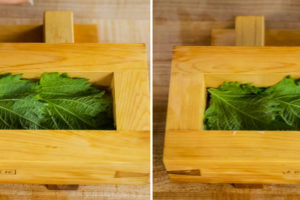
- Add rice from one side to the other. Using your fingers, fill the rice right into the corners and try to keep the amount of rice even all over.
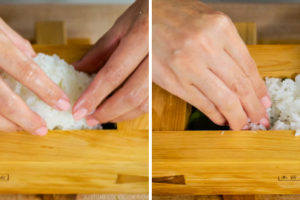
- Add more rice if necessary and fill the mold just right above the rim.
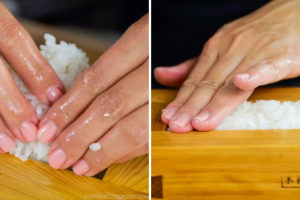
- Place the top piece of the mold and use it to press down on the rice firmly.
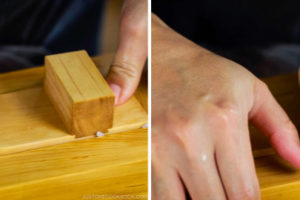
-
Rotate 180 degrees and press down again firmly with your body weight.
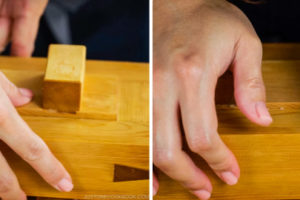
-
Flip the mold so the top piece is now at the bottom. Slide the sidewall of the mold down.
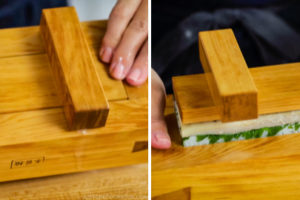
-
Remove the top piece. If the fish is stuck to the top piece, use a knife to detach. Push up the bottom piece through the sidewall.
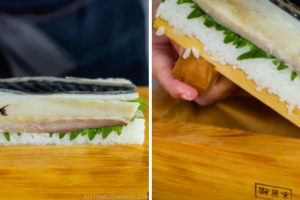
-
The completed oshizushi is now on the bottom piece. Insert a knife to detach from the bottom piece.
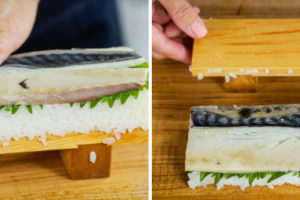
-
Cut the oshizushi in half and cut each half into 3 pieces. Serve on a plate and garnish with pickled ginger. You can repeat for another piece of mackerel. Clean the mold and moisten before making the second batch. Alternatively, you can use plastic wrap to avoid cleaning every time.
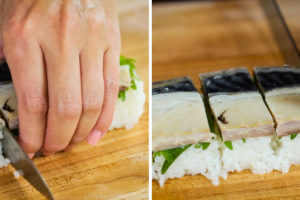
What to do with leftover Sushi Rice?
-
You can make Temari Sushi or Hand Roll Sushi for a quick sushi fix. Or you can freeze up to 1 month.
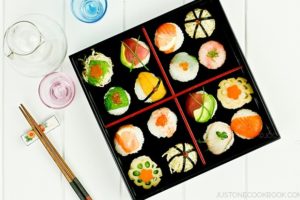
Recipe by Namiko Chen of Just One Cookbook. All images and content on this site are copyright protected. Please do not use my images without my permission. If you’d like to share this recipe on your site, please re-write the recipe in your own words and link to this post as the original source. Thank you.